You don’t need to be a very technical person, nor does it require a lot of money to learnhow to start a podcast. This guide will be your A to Z step-by-step walkthrough on how to get started with audio podcasting and why you should create a podcast. We’ll cover everything from the very technical to the abstract of podcasting concepts.
As a business owner, learning to start a podcast is something you should consider to help you reach this growing audience and expand your business throughcontent marketing.
Start a podcast in 13 steps
- Understand how podcasting works
- Identify a podcast theme
- Decide on a format
- Create your podcast brand
- Choose your podcasting equipment
- Get recording software
- Outline your first episode
- Record your podcast
- Record an intro and outro
- Edit your podcast
- Decide on podcast hosting
- Market your podcast
- Monetize your podcast
1. Understand how podcasting works
If you understand the value of creating content (e.g., blogging) for your business and brand, then you understand the value of podcasting. Creating a podcast lets you reach a brand newtarget market: people who might otherwise never find or consume your long-form content because they prefer the audio format.
The audience for podcasting has grown significantly in recent years. According to Edison Research’s 2020 report,The Infinite Dial, 57% of Americans over the age of 12 have listened to a podcast, and 78% of Americans are now familiar with podcasting, a 4.72% year-over-year increase. In 2020, US weekly podcast listeners averaged six podcasts each week.

Some benefits of running a podcast include:
- You don’t need to be an established content creator or have a blog to become a successful podcaster.
- A podcast is an excellent way tobuild an audiencefrom scratch and position yourself as an authority in your industry.
- Podcasts are a popular content platform because they’re easy to consume. People can listen to podcasts on the go, in the car, at the gym, and even at work.
- Midroll found that61% of listenerspurchased a product or service after hearing it advertised on a podcast.
- Most podcasts are free. They’re free to create and free to listen to.
One of the best things about podcasting is the intimate connection you build with your audience. These listeners will spend 30 minutes or more with you at any given time. In this day and age, where social media has shrunk attention spans, that amount of attention is pretty rare giving you the ability to dive deep into topics.
Podcasts can be played one of two ways.
- Streaming or downloading the podcast from the RSS feed, either in a feed reader likeFeedlyor on the blog/podcast website where the podcast is hosted or embedded.
- Using a player such as Apple Podcasts orPocket Casts.Play any of the episodes in the feed on a device, such as a smartphone or tablet. These are sometimes called “podcatchers.” Podcast players sync the data from the RSS feed to give a listing of episodes, show data (such as episode name and show notes), artwork, and a link to the show file (usually an MP3).
Identify a podcast theme
The first thing you need to do to start your podcast is identify a theme. It’s important that when you do this you stress test your idea by writing out at least 20 episode topics, including what you would discuss and who you would interview, if you were interviewing someone.
A stress test is critical, because if you can’t think of 20 episodes, you’ll probably run out of ideas before your podcast ever picks up steam. You need to make sure your idea has a good foundation. For example,The School of Greatnessby Lewis Howes just passed 1,220 episodes. Great podcast themes have longevity.

When choosing your podcast theme, take this into consideration: will you be happy and satisfied making new episodes on this topic two years from now? Choose something you’re passionate about. Your passion will be your greatest motivator to keep you disciplined when things get difficult.

Once you decide on a theme, ask yourself the following questions:
1.What’s the goal of your podcast?Some reasons include generating leads for a business, building authority on a topic, and earning passive income.
2. What’s the “why” behind the podcast?嫁给你r practical reason with an intrinsic purpose to stay motivated. What is the message or mission you want to share with the world?
3. Who is the show for?Create an avatar of your ideal listener. It’ll help you better understand how listeners think and feel, so you can address them directly. It also helps create a more intimate feel for your podcast that connects with listeners.
Consider:
- What interests they have
- Their beliefs
- Their activities and lifestyle
- Their favorite things
Spend time to develop an actual premise. The main reason a show may fail is it lacks a compelling premise.
Consider how your podcast will help your listeners. If you can create educational material that is also entertaining, you’ll foster more enthusiastic and excited listeners who tune in weekly to your show.
Know yourwhy. What’s your reason for doing the podcast? This will help you gain traction, build momentum and stay committed.
Decide on a format
The next important component is the podcast format. What will your podcast be like and how will it be structured? Here are some ideas:
- Interviews.These podcasts feature a single host who interviews individuals who fit with a particular theme. ThinkThe School of Greatness.
- Scripted non-fiction.Typically, these podcasts have a single theme for the entire season. ThinkSerial.
- News.These podcasts give you the news in a super digestible format. ThinkNPR’sUp First.
- Educational.These scripted non-fiction podcasts primarily seek to teach something. ThinkRevisionist History.
- Scripted fiction.These podcasts are similar to radio dramas and are often scripted and highly produced. ThinkLimetown.
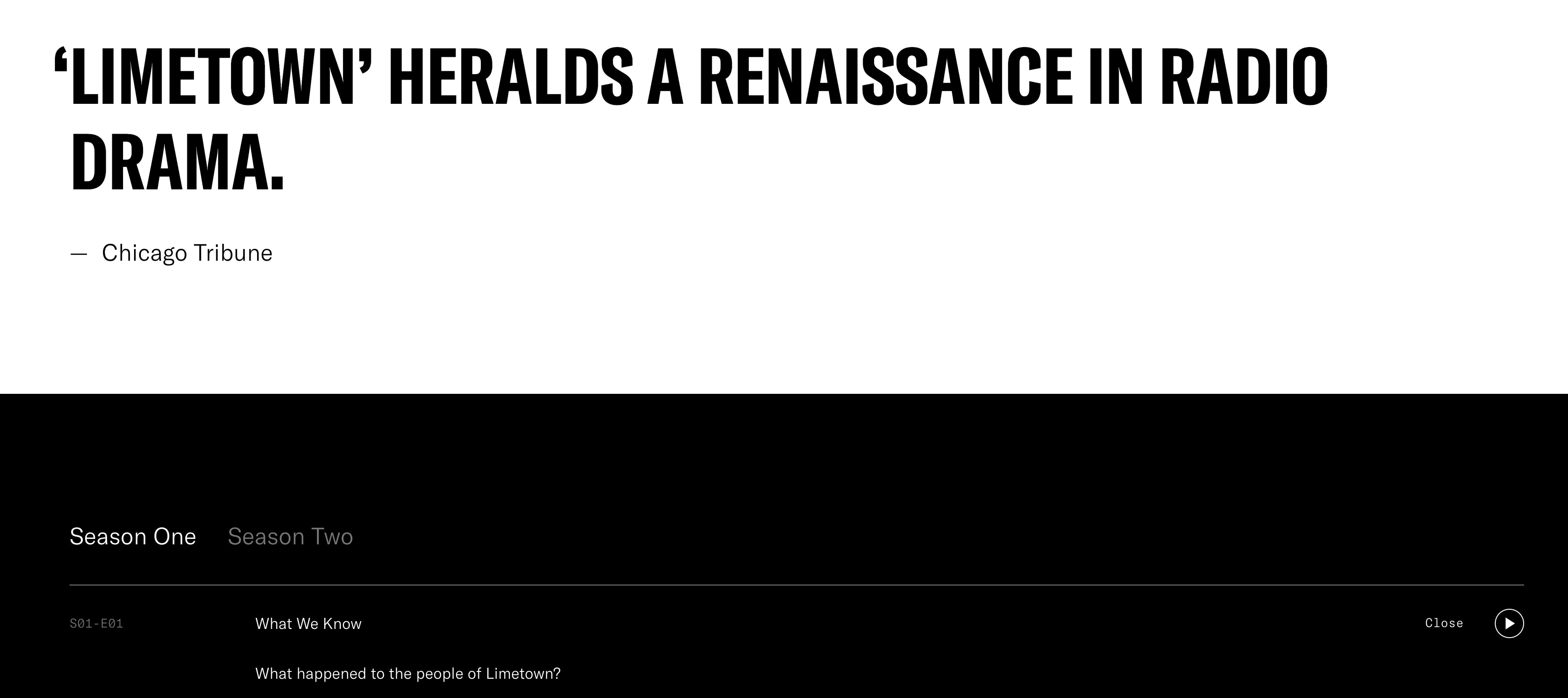
Once you’ve chosen a format, ask yourself:
- Are you going to do interviews?
- Will there be a co-host?
- Will you fly solo?
All of these formats can make great podcasts. It’s important to have a format nailed down, because it impacts the type of equipment and software you need to invest in to produce your show.
When it comes to format, two of the most common questions beginners have are:
How long should my podcast episodes be?
Episode length depends on how long you need to give your audience value, but not longer.
How often should I publish my podcast?
Consistency, not volume, is the key. No one wants to subscribe to a podcast that is unpredictable. Choose a publishing schedule that will be easy to maintain. You can always scale up later.
Create your podcast brand
Next let’s talk about developing your podcast brand. You want to put some care into your branding because it’s the first impression new listeners have of your podcast.
Name your podcast
Don’t underestimate the power of a name. Your podcast name should speak to you and your audience. Listeners should know what the podcast is all about from just the name alone.
Here are a few guidelines for choosing an excellent podcast name:
- Make it four words or less.
- Keep it succinct and intriguing.
- Avoid the words “The” and “Podcast.”
- Make it easy to spell and pronounce.
- Decide on a name you enjoy saying out loud.
- Make sure it’s not taken by another brand.
A lot of podcast platforms include a “hook” or short description along with the podcast name. However, don’t get too hung up on this. Make sure to include keywords that make it easier for people to find your podcast, but avoid keyword stuffing or you could be penalized.
Choose your category
There are many podcast categories to choose from: news, arts, culture, and much more. Listeners browsing these categories for new shows will do so by interest, so it's important to choose a category that accurately represents your podcast.
If your show is listed in a category that’s completely irrelevant to its content, you will run the risk of being removed from some directories.
According toStatista, the top 10 podcast genres (by share of weekly listeners) in the US are:
- Comedy(22%)
- News(21%)
- True crime(18%)
- Sport(17%)
- Health and fitness(17%)
- Religion and faith(16%)
- Politics(16%)
- Self-help and productivity(15%)
- Investigative journalism(13%)
- Finances(13%)
Description
Take writing your podcast description seriously. It’s the thing that possible listeners read that will help them decide whether to listen to your podcast or not. Each podcast directory gives you a different character limit. For example, Apple Podcasts gives you 4,000 characters (which is a lot of words), but between 400 and 600 is the sweet spot.
TakeThe Unofficial Shopify Podcast, for instance. The description is around 480 characters and tells you exactly what to expect:
- New episodes every Tuesday
- Answers to your burning growth questions
- Insights from ecommerce and Shopify experts

When writing your podcast description, be sure to:
- Make it engaging
- Ask a question
- Describe what you’re about
- Include your podcast’s value proposition
记住,播客平台搜索引擎also. You’ll want to include relevant keywords so people can find your show when searching for new podcasts.
Cover art
As your first impression, your cover art needs to be beautiful, stand out, and visually communicate your subject.
Here are some best practices:
- Your cover art should be a minimum of 1,400 by 1,400 pixels and maximum of 3,000 by 3,000 pixels.
- Compress files to optimize for mobile use.
- Don’t use too many words in your artwork
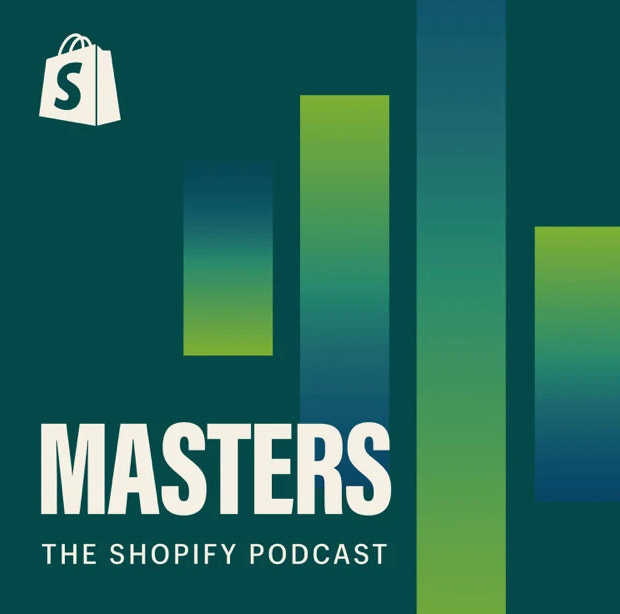
You can easily create cover art for free usingCanva. If you lack an eye for design, you can easily find highly skilled designers onFiverror99designs.
Choose your podcasting equipment
Now that we have your podcast’s brand down, let’s discuss the tools you’ll need to start. Truth is, if your podcast doesn’t sound great, nobody is going to listen for long. Most people listen to podcasts in headphones—bad sound quality isn’t just distracting, it’s uncomfortable. So having the right podcast equipment isn’t a nice-to-have, it’s a must-have.
Having the right podcast equipment is a must-have, not a nice-to-have.
First let's talk about microphones. When it comes to mics, there are three major categories.
USB麦克风.USB麦克风are the most accessible for people starting out, as you just need to plug them into your computer’s USB port, open your recording software, and you’re good to start recording. They are the most affordable and easiest to work with, but have the worst sound quality compared to other mics.

Popular USB mics include:
- Blue Yeti(best USB microphone overall)
- JLab Talk(best mic for under $100)
- Blue Snowball iCE(best USB mic on a budget)
Dynamic mics.These mics reject background noise well and, as a result, are a great choice when you have two people speaking. They are also durable and don’t require external power. Dynamic mics are often used by radio announcers, broadcasters, musicians, and podcasters.
One con to dynamic mics is that their lack of sensitivity means you need to keep your mouth close to the mic to ensure consistent recording levels.

Popular dynamic mics include:
Condenser mics.Also known as capacitor microphones, these mics are known for excellent audio quality and sensitivity. These mics require 48V phantom power or batteries to operate. Condenser mics are much more suited for quiet, sound-treated spaces, as they are a lot more sensitive.

Popular condenser microphones include:
Can you start a podcast with just an iPhone?
简短的回答:是的。自从iphone microphones, they have everything you need to record audio. However, the audio may not be as clear or as professional sounding as you’d like.
That being said, there are several apps you can download that will turn your iPhone into a podcast audio recorder. Podcast hosting services, such as Podbean andSoundCloud, also offer in-app podcast recording capabilities. Many of these apps are available for Android devices, too:
- Anchor(iOS and Android)
- Spreaker(iOS and Android)
- iRig Recorder(iOS and Android)
Podcast recording equipment to improve quality
Beyond microphones, here is some other gear that can boost the quality of your production.
Pop filter (typically $5–$20).Pop filters help keep the clicking noises your mouth makes when speaking close to the microphone from being recorded. It prevents the sound of plosives, which are really harsh consonant sounds like p’s or b’s.
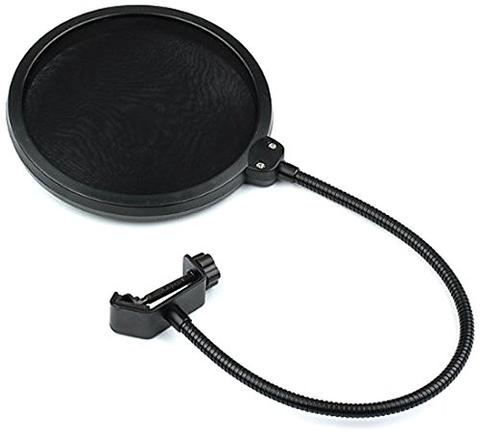
Desktop microphone stand or boom pole:Boom arms help keep your podcast microphone in front of you, hands free. They also allow you to easily adjust the height and distance from your mouth on the fly, so you can move around while you podcast or simply keep your mic out of sight when you’re not recording. This is handy if you’re recording at your home office desk.
You can pick up aNeewer Broadcast Studio Mic Boom Armfor around $33.
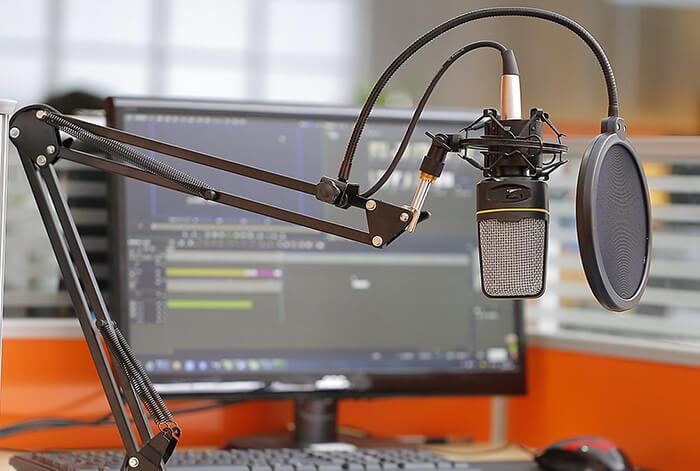
Over-the-ear headphones.Unlike earbuds, over-the-ear headphones offer noise rejection, better sound quality, and more comfort.
Two solid options are:
- Sony ZX series stereo headphones($20).A good pair of headphones is important if you’re interviewing guests. You don’t want to have their speech come through your speakers and get picked up by your microphone, which would cause echo.
- Sony MDR7506 professional headphones($95).If you have a bit more in your budget, these headphones are an industry standard and ideal for monitoring recording and listening back to audio when editing.
Shock mount.This tool suspends the microphone and prevents vibrations. Most microphone brands offer their own compatible shock mounts. There are some universal microphone shock mounts, likeRycote, that allow you to easily attach microphones of different shapes and sizes easily.
XLR connections
If you’re opting to use a USB microphone, then an interface isn’t something you’ll need. Simply plug your microphone directly into a USB port on your computer and select your microphone as your audio input in your recording program settings.
But if you are using a condenser or dynamic microphone, these require an XLR connection.
For this, you have three options:
- An audio interface like the Focusrite Scarlett series.An interface is a piece of hardware that expands and improves the sonic capabilities of a computer, giving you the ability to connect professional microphones. They act as a middle man, allowing sound to go in and out of your computer.
- Hook up your XLR microphone to an external audio recording device.This means you can record independently of your computer and can host a podcast episode anywhere. External audio recorders will save your audio to an SD card that you can upload to your computer later when you start editing.
- A podcast machine.Companies like Rode have created standalone podcast machines that give you recording, effects processing, and an intuitive console to control it all. These are typically on the more expensive side and are a better option for upgrading to later than starting out with.
Get recording software
Now once you have all the hardware, you’ll need to use software for recording and sound editing.
Audio recording software
The software recommended in this section will allow you to record the audio from your microphone and save it as an MP3 file. The following software will also let you edit your recordings.
Adobe Audition(PC/Mac; $20.99 per month).If you want really powerful audio editing software with all the bells and whistles, Adobe has it with Audition. It might be more than what you’ll need to edit your podcast, but if you’re using a mixer and high-end equipment, it could be a good idea to look at Adobe Audition as well.

Audacity(PC/Mac; free).Audacity is a great alternative to paid premium audio-editing software. It’s easy to use and there are a lot of tutorials available online to help you.

GarageBand(Mac; free).GarageBand comes with all MacBooks and is good enough for most of your audio editing needs. GarageBand allows you to record the audio from your podcast microphone and save it as an MP3.

Call recording software
If you plan on conducting interviews for your podcast, you might want to use software that records your calls. If you’re using a mixer that records all sound from your computer, this software won’t be required.
However, if you’re using a basic setup and a tool like Skype or Google Hangouts to conduct interviews, here are some recommended call recording tools:
- Zencastr(PC/Mac; free to start).Record remote interviews in studio quality by sending a link and receiving a separate track for each guest.
- Ecamm Call Recorder(Mac; $39.95).Record Skype calls on your Mac.
- Dialpad Meetings(PC/Mac/iOS/Android; free to start). The free conference call software allows participants to join the call via desktop or phone, and the moderator can record the calls.
- Callnote(PC/Mac; free to $9.95 per year).Callnote records Skype, Google Hangouts, Viber, FaceTime, Facebook, GoToMeeting, and WebEx conversations.
Outline your first episode
No matter how good your recording is, there is no substitute for great content and a confident performance. Your podcast can’t just sound great, it needs to be worth listening to.
A key to making this happen is creating an outline.
Unless your podcast is meant to be scripted, you don’t need to script the entire show. You just need to create an outline based on the transformation you want your audience to have.
Start with the end in mind. What's the purpose of this episode? What's the take away that you want your listeners to have? Picturing your listener avatar while creating an outline can be incredibly helpful.
A good outline includes a hook to grab the audience’s attention, introductions for guests, interview questions, talking points, transitions, and closings. These not only help make the podcast go smoother, but also show your guests that you came prepared.
Here is a generic episode structure that you can use to fill out your outline:
- Hook (teaser)
- Intro
- Welcome/episode overview
- Ad spot
- Interview
- Call to action
- Outro
No matter how good your recording is, there is no substitute for great content and a confident performance.
Record your podcast
Recording a podcast seems a lot more complicated than it really is. It takes the following series of steps to prep and manage an effective podcast recording.
1. Find a room with solid sound
Try and choose a space with minimal noise. Think about things in your environment that might make noise. Is there a fan on your computer? Refrigerators? Cellphones? Cats? Dogs? A television? A cleaner recording will be easier to handle later on in the process.
If you have hardwood floors or rooms with a lot of windows, try and minimize echo. While it is most effective for professionals, you don’t need to spend a bunch of money on sound treatment right off the bat. Echo can be really easily reduced with movers blankets. Soft objects absorb sound and help create a cleaner recording.
2. Adjust your systems
Adjust system preferences to make sure that sound from your microphone is going into the computer. If you’re using a condenser microphone, ensure that phantom power is running.
Open software and change bars and beats to time. Since you’re recording a podcast, not music, we don’t need bars and beats.
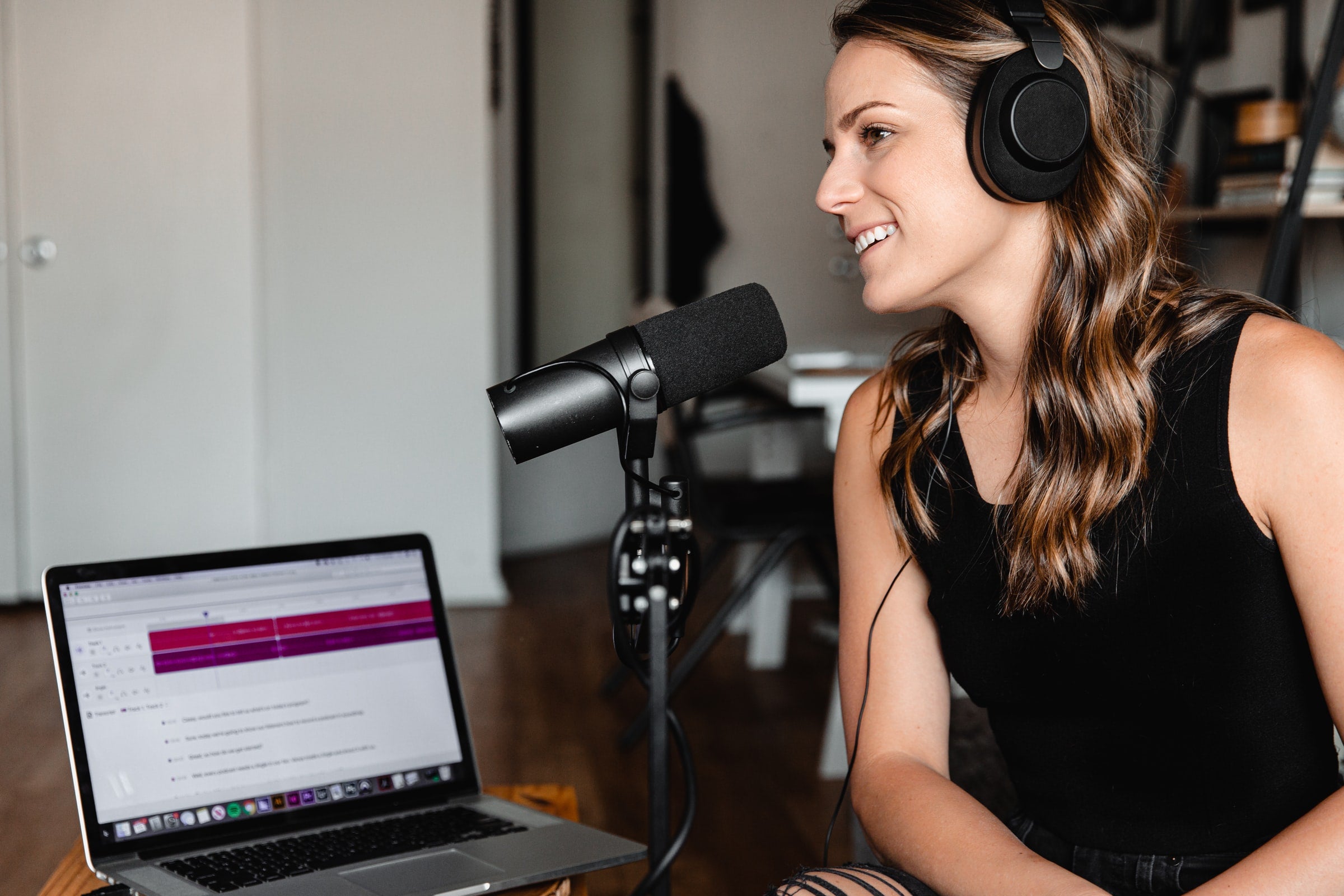
3. Set a conservative recording level
Set a conservative recording level. Never record audio that is too loud. You can always make things louder later on, but if you record too loud, your recording will sound distorted.
To set a good, modest input level, speak at a normal-to-loud speaking voice, and aim to make this level around -20 dB, or about halfway up (yellow) on most meters.
Then test with a hearty laugh or emphatic phrase to make sure the level never peaks above 0 dB or goes “into the red.”
4. Record a high-quality audio file
Compression artifacts, which are noticeable sound distortions, compound over time. So make sure your initial recording is a high-quality WAV or AIFF file. Resolutions of 24 bit, 48 kHz are great. Even though you’ll probably be uploading your podcast as an MP3 or AAC for distribution, you want to start off with a high-resolution format.
5. Be consistent with your mouth placement and tone.
Pay attention to where your mouth is in relation to the microphone. You don't want to have wide-ranging volume levels. Try setting your microphone up slightly to the side so those bursts of air don’t go directly into the diaphragm.
Don’t set it up at too extreme of an angle or you will be working against the pickup pattern of directional microphones.
6. Make a test recording
When setting up your podcast recording environment for the first time, it can be helpful to listen to a test recording in comparison to other podcasts’ quality. Try listening to your test recording through headphones, car speakers, cellphone speakers, a laptop etc.
7. Always record 30 seconds of silence
This helps you capture the noise print (kind of like a sonic fingerprint) of the room and will be helpful in post-production
Pro tip:Don’t be self-conscious about your voice. You don’t need a radio voice to get people listening. Everyone hates the sound of their voice at first and, eventually, you'll get used to hearing it.
Record an intro and outro
Having an intro and outro for each episode of your podcast adds flair and personality. Usually, they are short voiceovers with intro music that covers the podcast, the episode number, the host(s), and the “hook” or tagline of the podcast. These intros/outros are also sometimes called bumpers.
A great podcast intro will hook your listeners and give them a glimpse into the value your podcast is going to deliver. It should tell listeners:
- Who you are.In one sentence, introduce yourself, highlighting your experience and why your perspective matters.
- What your podcast is about.In one or two sentences, state clearly and concisely what your podcast’s purpose is.
- How they’ll benefit from listening.This is the most forgotten, yet most important, part of a great podcast intro. You need to tell the listener how your podcast is going to improve their life.
An excellent podcast outro thanks listeners for tuning in, includes your tagline, and gives them something to do next. This is called a call to action and really helps to develop a deeper relationship with your audience.
Here are some example actions you might want your listener to take:
- Leave a review on Apple Podcasts
- Join your email newsletter
- Support your show on Patreon
- Follow you on social media
Pro tip:Only give one call to action per episode. The more things you ask your listeners to do, the less likely they are to take action.
If you’ve got the chops, you can record these yourself. Alternatively, you can hire someone with a great voice to create your podcast music and record your intro and outro for you. I’ve usedFiverrin the past to create the intro and outro for my podcast.

Edit your podcast
编辑你的播客允许您添加你的介绍and outro, stabilize the volume, and remove gaps of dead air and any mistakes you might have made. Any of the software recommended above (e.g., Adobe Audition, Audacity, GarageBand) should do the trick.
For a lot of people, editing is the less appealing part of podcast production. But it’s not an optional part of the process.
The reasons for this are simple:
- Often, conversations can result in tangents.Less is more. Cut the fat and only keep the good parts.
- Poor quality audio can result inlistener fatigue.This is when the act of listening takes too much effort and focus, causing the listener to get tired and exit early.
The most common editing mistakes:
1. Music too loud.Make your music softer than you think it needs to be. Then listen to your intro in a variety of environments and with several different devices (car stereo, headphones, in the kitchen, etc.) to hear how it will sound to your listeners.
2. Too long of an intro.Your intro should move at a quick pace, roughly 20 to 30 seconds in length. Don’t let it overstay its welcome.
3. Using copyrighted music.Unless you get permission from the artist and the recording label to use a track, you can’t use it. However, there are plenty of royalty-free music options that easily solve this problem:
- YouTube Audio Library
- 909 Music on Soundcloud
- The Free Music Archive
- Epidemic Sound
- Soundstripe
When editing, your first pass should be to edit the content to make a cohesive and engaging podcast. Your second pass should be to clean up the audio.
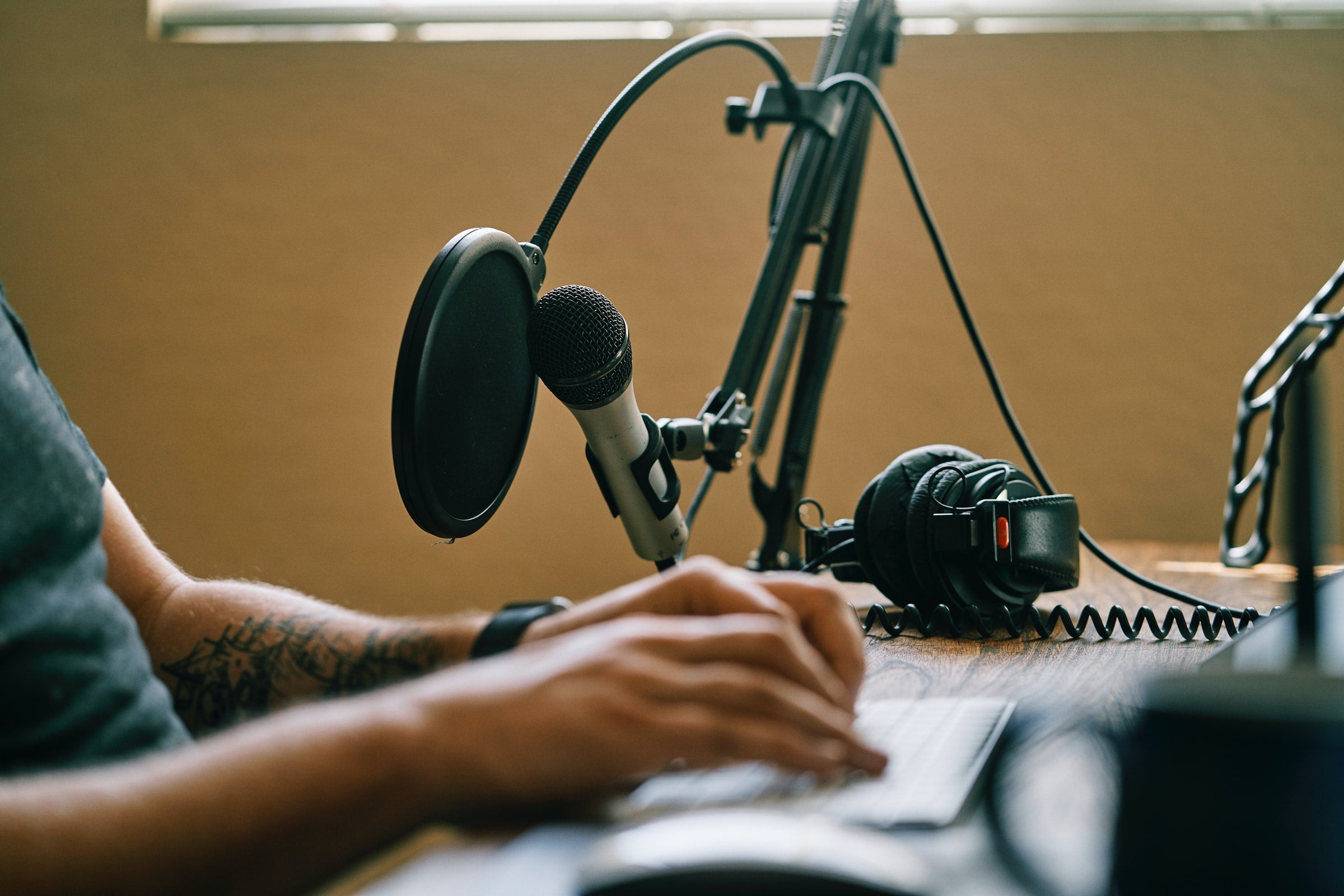
Some pro-tips to make your audio sound more professional:
- Remove gaps of dead air,as these will be highly noticeable to a listener.
- Crossfade between tracksto avoid any jarring transitions.
- Use noise reductionto filter out any unnecessary background noise.
- Use a high-pass filterto let sounds above a certain frequency to pass through while everything else is filtered out. Because most speaking voices don’t generate any fundamental frequencies below about 85 Hz, you can set a high-pass filter around 80 to 100 Hz to help remove rumble and plosives that your listeners won’t want to hear anyway.
- Use equalizationto compensate for certain frequencies that might seem to stick out in the recording. Don’t cut or boost anything more than 6 dB, as you want the recording to sound natural.
- Add compressionto even out your sound and ensure that the loudest parts are closer to the average volume of the recording. While this is a really helpful tool, don’t use it in extremes. Start with a ratio of 2 to 1.
- Use a de-esser.A common problem you may run into with vocal recordings is the harsh presence of “s” and “t” consonants in words, called sibilance. A de-esser gets rid of this unpleasant sound and makes the voice easier to listen to for longer periods of time. Again, less is more.
- Master your audio to bring your podcast to a loudness range that is similar to other podcasts.Peak level represents the volume before the sound starts to distort. Generally, a peak level of -1 dB is good for podcasts. Your RMS level is the average level of your signal. An RMS level around -16 dB to -12 dB is a great range.
If you don’t have time or interest in editing your podcast, don’t let that stop you. You can hire someone to edit your episodes for you. There are freelancers on Fiverr and Upwork. There is even a professional service for this very purpose calledWe Edit Podcasts.
Decide on podcast hosting
One common thing people misunderstand about podcasts is that you don’t upload them directly to platforms like Apple Podcasts, Spotify, or Stitcher. Instead, you’ll need a separate host for your audio files.
Do to this, you use a podcast hosting platform, like:
Once you have your podcast hosted, you submit an RSS feed. An RSS feed is a standardized way to syndicate content to podcast directories. It ensures that your episodes are automatically placed on directories, adding all the necessary code to ensure that your listeners see all the proper titles and descriptions and hear the right audio file.
If your podcast is hosted through Buzzsprout, then you can submit your podcast to all of the major directories directly from your dashboard. It's that simple.

Pro tip:Before launching your podcast, try and have three to five episodes recorded and edited. Launch the first three so your first listeners have a few episodes to get to know you better. Keep two to release in your regular publishing schedule. That way, you’ree ahead of production and won’t ever feel like you’re creating down to the wire.
There are many directories where you can list your podcast. I’m going to recommend the most popular, but you can distribute your podcast across as many channels as you’d like. You’re going to be asked for your podcast’s name, description, category, artwork, etc.
- Apple Podcast
- Stitcher
- SoundCloud
- YouTube
- Spotify
- Google Play
Apple Podcasts
Apple Podcastsis the largest podcast directory and it should certainly be your focus. If you’re only going to submit your podcast to one directory, this is it. To learn how to upload to Apple Podcasts, head over to theApple Podcasts for Creatorspage to create an account and submit your podcast.
Stitcher
Stitcheris the second largest podcast directory and another great way for people to discover your podcast.Basic Brewing Radio, for example, is a podcast on Stitcher that discusses homebrewing beer. Wine enthusiasts, on the other hand, can tune in to theWine for Normal People podcast.
SoundCloud
SoundCloudis another channel where you can list your podcast to amplify your reach. PlayStation, for example, has built up an audience of nearly 5,000 subscribers forits SoundCloud podcast.
YouTube
You might want to put your podcast up onYouTubeto reach even more people. You’ll need a video file to upload as you would for any other YouTube video. For the visuals, you can use a static branded image that complements your other artwork. Or you can include a video.
Spotify
Spotify是播客由于主要目录e of its popularity with music streaming and ability to make relevant music and podcast recommendations. The directory is growing quickly, so you want to get your podcast in its feed to improve visibility. Start by heading over toSpotify for Podcastersand follow the steps to submit your show. It can take two to five days to appear on the podcast listings, but usually shows up in a few hours.
Google Play
Starting a podcast on the Google Play store is a great way to reach more potential listeners. Start by visiting theGoogle Podcasts Manager. Click Add a Podcast and paste your podcast’s RSS feed URL, then click Submit RSS Feed. Once you verify ownership of your podcast and review the info, publish the podcast and wait for approval.
Market your podcast
When you launch, there's an opportunity for you to be featured in the New & Noteworthy section on Apple Podcasts. Just imagine how much this could grow your podcast in a short period of time. This would give your new podcast a lot of traction.
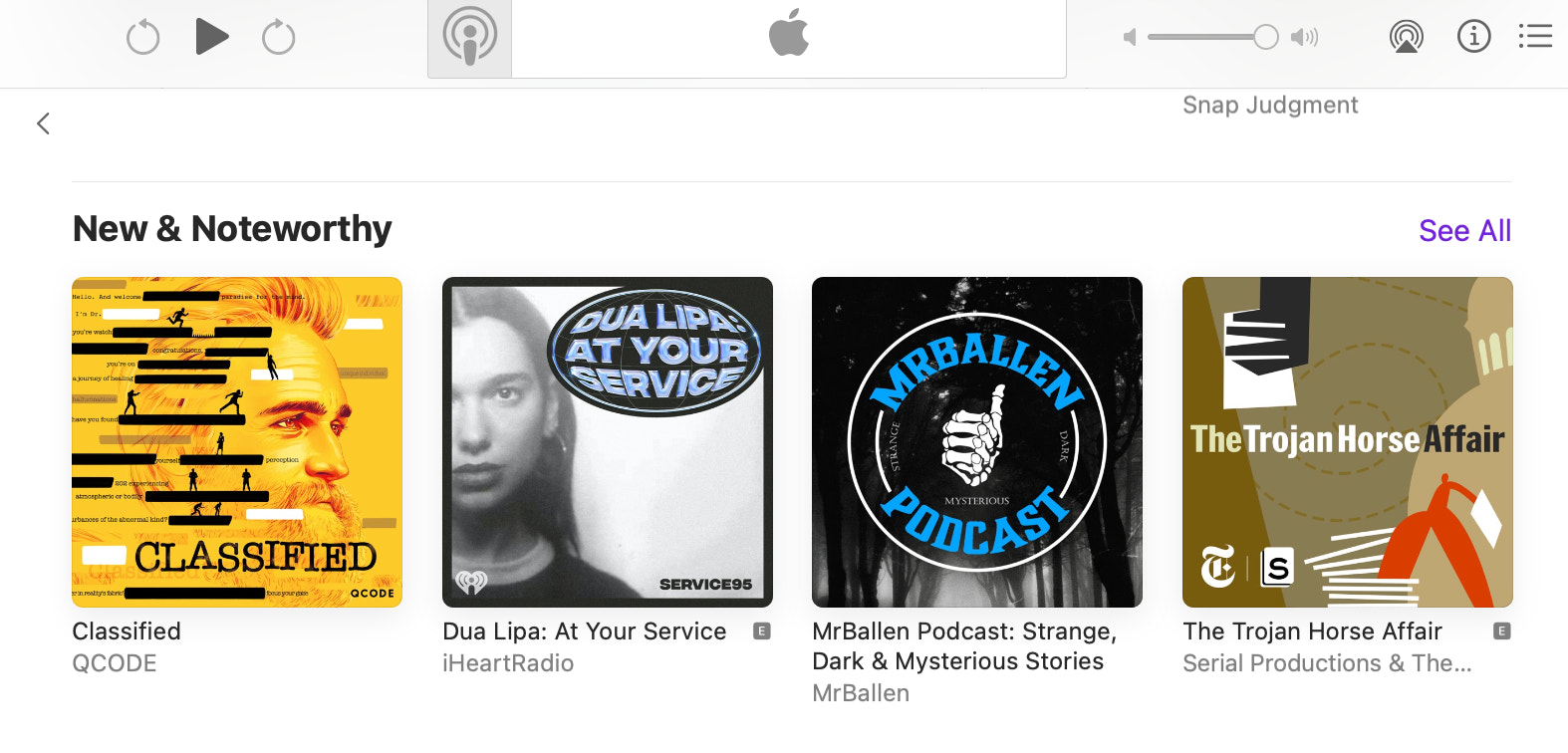
To get noticed by Apple Podcasts and increase your chances of being featured, you’ll want to launch your podcast in a way that you receive some listens and reviews immediately. This is going to put you in the position to be featured. While it still isn’t guaranteed, launching your podcast this way will help you grow organically, too.
To do this, make the launch of your podcast an event and generate buzz around it.Create a landing page你的播客,让人们知道你甲型肝炎e planned. This landing page should also give people the chance to opt into a mailing list, which you can use to reach out on launch day.
Building a small audience pre-launch is critical, since it can help create a snowball effect.
The day you debut your podcast, you should launch it with a few episodes, ideally three. This is a good number of episodes to have your audience listen to immediately without overwhelming them. If you launch with just one episode, you likely won’t get the listen numbers you need to get noticed by Apple Podcasts.
You also need to show your listeners that you'll be putting out content regularly, and that there’s something to subscribe to. Having multiple episodes at launch (i.e., showing episode #1, episode #2, etc.) implies that there’s much more to come.
Announce the launch to your email list, and ask them to subscribe to the podcast and leave a review after listening. It’s really important that you encourage your subscribers to leave a review, as having reviews (and subscribers) the first day can help you get noticed by Apple Podcasts, increasing your odds of getting featured.
Some other simple marketing ideas include:
- 使用工具,如重新。io和wavve。公司以create little snippets of your audio in video format and publish it on social channels.
- Create transcriptions of your episodes to improve yourSEOand get found through Google.
- Leverage your guests’ audience to spread the word about new episodes.
- Be a guest on other people’s podcasts.
Monetize your podcast
There are different ways to monetize your podcast. Your focus first should be to build your audience and their trust. Then you can think about monetization.
除了广告之外,还有其他方法赚钱podcasting:
- Sponsorships.This is when the podcast promotes a sponsor during the show. How much you make from sponsorships depends on how many downloads your show gets. Sponsors typically pay on a cost-per-1,000 basis, with rates ranging from $18 to $50 CPM.
- Direct support.Direct support is when a host asks listeners for money to support the show. If people love your content, they’ll likely throw some money your way to help keep the podcast running.
- Affiliate sales.Podcasters can also earn money from affiliate marketing. Rather than make money per download, you will typically make a percentage of what you sell for the company you’re promoting.
- Selling products.One common way podcasts make money is by selling products that complement the show. This can include merchandise, consulting services, books, live events, courses, and more.
After you have a few podcast episodes launched and have begun to build an audience, you can begin to think about monetizing your podcast.
Best podcast business tips
Now that you know how to start your first podcast, keep the following tips in mind before and after you hit the Record button:
Make mistakes
Mistakes are a part of life. Every mistake you make, whether in podcasting or your personal life, are valuable lessons gained. You learn from them and become better. Don’t be afraid to make one. You can always try again.
[Your first podcast] won’t be perfect. I livestream my podcast and all kinds of things end up happening. The Internet won’t work, the audio is delayed, you name it, it probably has happened. Just roll with the punches and make it interesting and human.
Keep moving forward
We’ve all felt stuck or unmotivated at some point in our lives. When that happens with your podcast, it can feel impossible to move forward. Reconnect with your purpose. Podcasting can take time to get traction and see results, so you need to stay motivated.
Stick with it and be consistent, even if you're not seeing amazing results right off the bat. Keep on keepin’ on and make it a constant feedback loop with your listeners.
Relax
Try to not be too self-conscious about your voice. You don’t need a professional voice to get people listening. Speak naturally.
If your voice sounds shaky or nervous, remember that improving your confidence on the mic takes a lot of practice. When I listen back to my first few podcasts and compare them to today’s, I can see how much I’ve improved.
Remember that you can always clean up and edit the audio after you’re done recording. If you lose your spot or forget your next point, don’t be afraid to sit in silence until you can regain your composure and continue. You can edit those gaps and mistakes out later.
You don’t need a professional voice to get people listening. Speak naturally.
Avoiding reading from a script
Your podcast should sound natural. People who listen to podcasts don’t want to hear an audiobook. They’re used to listening to the dynamic conversations and discussions that happen on podcasts. It’s OK to have a few bullet points to work off of, but practice speaking about topics off the top of your head.
Make guests feel comfortable
When conducting an interview for the first time, it’s really important that you focus on making the guest feel comfortable. Before hitting Record, make sure to warm the guest up and build rapport. Creating a welcoming environment will go a long way to getting more insightful answers.
You’ll want to make sure that you have questions prepared, but don’t be afraid to divert from them. Ask follow-ups that prompt them to go deeper. Sometimes the real magic happens when the conversation begins to flow naturally.
Start your podcast today
You can create a successful podcast today. Begin with the podcast listing information and start looking on Apple Podcasts or Spotify for podcasts that are doing what you want to do. If you already have an external microphone, record a short episode today, introducing yourself and your podcast idea.
When diving in, get comfortable talking into a microphone for a long period of time and then listen to yourself afterward. You don’t have to upload the episode you record today, but it’s good to get some practice and familiarity with the process.
Illustration by Till Lauer
Ready to create your first business? Start your free trial of Shopify—no credit card required.
Starting a podcast FAQ
What are the benefits of starting a podcast?
- Popular content platform because they are easy to consume.
- Great way to build an audience and build authority.
- You don’t need experience to start a podcast.
- You can earn money through partnerships and direct sales.
- Podcasts are free. They’re free to create and free to listen to.
Do podcasts make money?
Popular podcasters can make $25 to $50 for every 1,000 host-read podcast ads. Jeromy Sonne, co-founder of audio advertising service,Decibel, reports the average podcast advertising rates in 2021 were around $12 CPM for programmatic advertising, but that number varies widely.
Podcast advertising spending in the US is expected to surpass$1.74 billionin 2022, up 30% from 2021. If you want to start a podcast business that makes money, now is the time.
What are some free podcast hosting sites?
- Anchor
- Acast
- Buzzsprout
- Podbean
你可以开始免费播OB欧宝娱乐APP客?
Yes, you can create and set up a podcast for free by using a free podcast hosting service and free audio software and uploading your shows to sites such as Apple Podcasts, Spotify, and Google Podcasts for free. However, one of the biggest podcast recommendations is to invest in a good microphone to improve sound quality.

